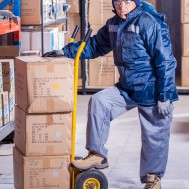Work-related injuries are all too common within the field of manufacturing, where physical demands are always present to workers on the job. The problem is that in this type of work environment, it is not unusual for some of these work-related injuries to get swept under the rug. This is likely because of the recurrent nature of these injuries. Individual workers may be worried about calling attention to themselves as a “special case.”
Back injuries, in particular, have unfortunately become mainstream in manufacturing. One of the root causes of many long-term back injuries is overuse. This goes hand-in-hand with overexertion, which consistently ranks number one out of all work-related injuries.
Back injuries for manufacturers should not be taken lightly. Here are 5 ways you can prevent one in the workplace.
1. Introduce stretching as part of the workday.
Stretching is not just for yogis anymore! A 2009 report that considered the benefits of stretching in the workplace says that workplace stretching is associated with a reduced risk for musculoskeletal disorders (MSDs), which include sprains and strains of the lower back. This is incredibly relevant with the knowledge that work-related musculoskeletal disorders make up more than 30 percent of occupational injuries and illnesses annually. Especially for manufacturers that are always physically active, a main benefit of stretching is improved flexibility and range-of-motion.
2. Understand proper lifting techniques.
Repeated lifting of an object is often a basic part of a manufacturers’ job description. However, there are preventative measures that can be taken to minimize the amount of stress you put on the muscles in your back. Objects that are excessively heavy and may require repeated lifting on the job should be stored. The motion of bending over to lift up dead weight maximizes the force exerted on the back: lifting a 25 pound object from the floor imposes about 700 pounds of force on back muscles. Keep an open communication with management. Material handling devices such as dollies, carts, and forklifts reduce the amount of human exertion needed and should be used when possible.
3. Practice good posture at work and at home.
The stress that poor posture places on your spine can lead to anatomical changes. This will create unwanted pain and the opportunity for a long-term injury to develop. Manufacturing employees should be educated on what it means to keep a “neutral spine,” which prevents both fatigue and back injury. A neutral spine takes the shape of a long, stretched-out “S.” Keep an eye out for educational posters that may be hanging somewhere in the building to learn more about neutral spine. To preserve good posture in a physical job, move your feet towards an object instead of twisting to reach it and bend your knees, not your back, while lifting.
4. Listen to your body.
Your body knows what it can and cannot handle, and it is often after pushing past these initial warnings that work-related injuries occur. A good rule of thumb is to trust your instinct. If you’re not confident that you can lift something on your own, don’t. Instead, ask a coworker for help or see if you can lessen the weight in any way on your own or with devices to lift and transport. Some manufacturing employees feel that a certain degree of risk is required in order to do their job well, but a long-term back injury will affect the ability to do the job at all.
5. Know when it’s finally time to see a medical professional.
The human back is incredibly intricate: from the spine, to vertebrae, to nerves and tissues, to spinal discs. The problem with this multitude of parts is that the injury of one can have negative effects on another. Back injuries that are left untreated, which is common in the hardworking manufacturing industry, can increase the severity and prolong the timeline of the injury. An undiagnosed work-related injury can become a lifelong problem. There are several different suggestions on what differentiates manageable back pain from a type that needs medical attention. Some common symptoms come from a specific event that caused the discomfort, like a heavy lift or a fall, while other pain is more gradual and accompanied by numbness or tingling. Regardless of the cause of the symptoms, any pain should be monitored and discussed with a doctor.
